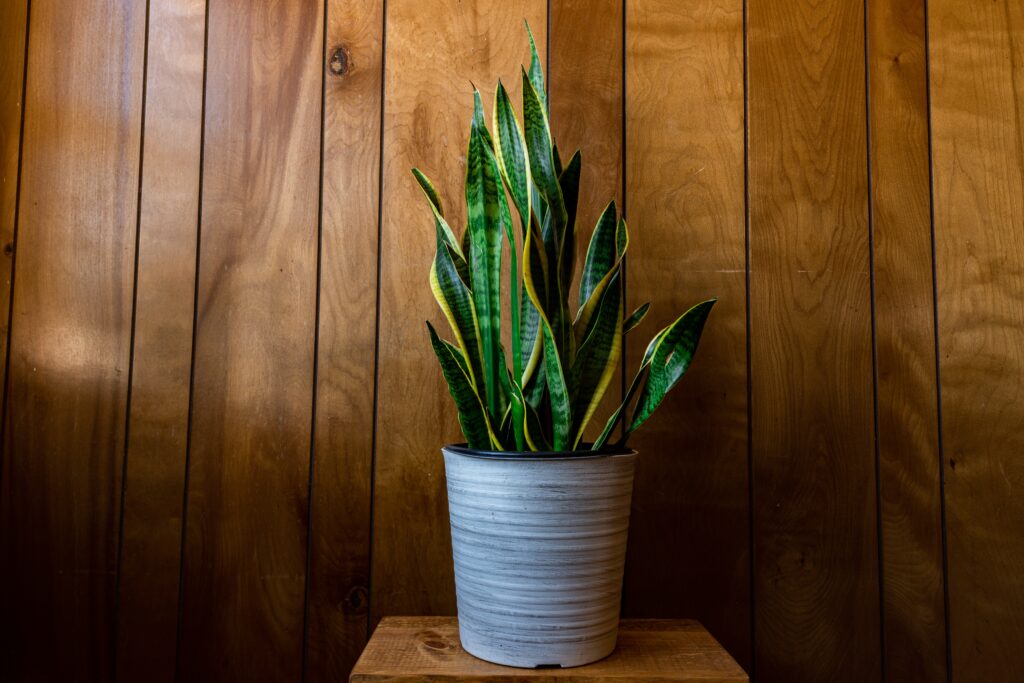Snake plants, sometimes called mother-in-law’s tongues, are famous houseplants recognized for their resilience and distinctive appearance. This guide will teach you all you need to know about caring for these tough plants, from basic information to common difficulties.
Quick Facts About Snake Plants
Botanical Name: Sansevieria trifasciata.
Common Name: Snake plant, mother-in-law’s tongue.
Origin: West Africa.
Height Range: Usually reaches from 6 inches to 4 feet in height.
Lifespan: Capable of living for numerous decades if well-maintained.
Snake Plant Benefits
Snake plants offer several benefits, making them ideal for homes and offic.es
Air Purification: They are known to filter indoor air, removing toxins like formaldehyde, benzene, and xylene.
Oxygen Production: Unlike most plants, snake plants release oxygen at night, making them suitable for bedrooms.
Low Maintenance: They thrive on neglect, requiring minimal care.
Pest Resistance: Their tough, leathery leaves deter most pests.
Care Instructions for Snake Plants
Snake plants are quite resilient, but they require proper care for optimal grow.th
Watering: Use water sparingly. Ensure that the soil dries out completely between waterings. Excessive watering can cause root rot.
Light: Can tolerate various light conditions, ranging from low light to bright, indirect sunlight.
Temperature: Ideally, it prefers temperatures within the range of 21-32°C. Avoid exposing it to cold drafts and temperatures below 10°C.
Humidity: Flourishes in low-humidity settings, which makes it an excellent choice for indoor environments.
Soil and Light Requirements
Soil: Opt for well-draining potting soil, preferably a cactus or succulent mix. Incorporating perlite or sand can enhance drainage.
Light: Snake plants can survive in low light but also do well when they receive bright, indirect sunlight. Direct sunlight should be avoided as it may cause leaf scorching.
How Often to Water a Snake Plant
Spring and Summer: Water every 2-4 weeks and let the soil dry out completely between watering in the spring and summer.
Fall and Winter: During the fall and winter, water less often, maybe once a month, as the plant’s growth slows down.
Fertilizer for Snake Plant
Type: An all-purpose, balanced fertilizer is suitable for use.
Frequency: During the growing season (spring and summer) fertilize once. Be cautious of over-fertilization, as it can result in nutrient accumulation and damage to the plant.
Snake Plant Propagation and Re-potting
Propagation: Propagation methods include leaf cuttings and division.
The leaf cuttings: slice healthy leaves into 2-3 inch slices, let them callous for a day, and then transplant them in damp soil.
Divisions: Extract the plants from the container, carefully divide their root ball into parts, and transplant every part into a fresh pot.
Repotting: Re-potting occurs after a couple of years or whenever a plant outgrows its existing pot. Choose a bigger pot than the previous one, and check that it has drainage holes.
Difficulties Growing Snake Plants
Root Rot: Root rot is caused by excessive irrigation or insufficient drainage. Check that the soil is well-drained and that the pot has enough drainage holes.
Leaf browning: The browning of leaves can be due to extended exposure to direct sunlight or cold air. Adjust the plant’s position accordingly.
Pests: Although uncommon, spider mites and mealybugs may be present. Wipe the leaves down with a moist cloth and, where necessary, apply insecticidal soap.
Variety of Snake Plants
Snake plants come in many different types, each with a distinct appearance.
Trifasciata ‘Laurentii’: Tall and variegated leaves with golden borders.
Cylindrica: It has cylindrical, spear-like leaves.
Trifasciata ‘Hahnii’: It is a dwarf cultivar with rosette-shaped leaves.
Trifasciata, ‘Moonshine’: Known for its delicate, silvery-green foliage.
FAQs
Q: Do snake plants live in low light?
A: Snake plants can live in low-light circumstances, but they will develop slowly. It prospers in bright, indirect lighting.
Q: How can I tell if I am over-watering my snake plant?
A: Over-watering can cause browned leaves, weak roots, and an unpleasant smell from the soil. Always allow the soil to dry completely before watering.
Q: Is it secure to have snake plants near pets?
A: Snake plants can be somewhat hazardous if consumed by animals or people; thus, keep plants away from the reach of curious animals and youngsters.
Q: How frequently do I need to re-pot my snake plant?
Re-pot your snake plant after 2-3 years, or whenever it becomes root-bound.
Conclusion
Snake plants require minimal care and can thrive in any indoor environment. They are an excellent choice for beginner and experienced gardeners due to their air-purifying qualities and versatility.


